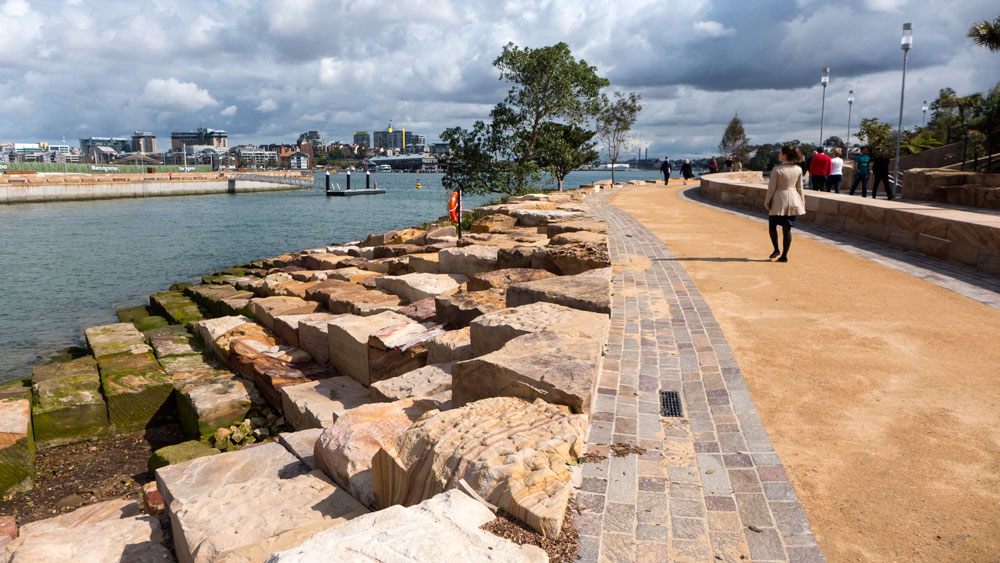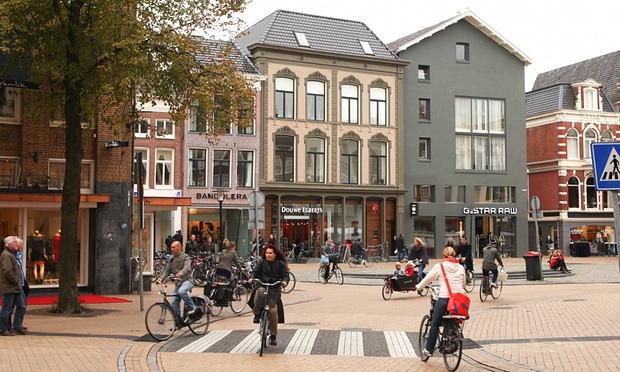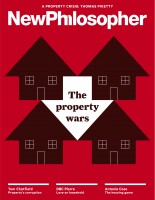
Barangaroo Reserve, opened to the public in August 2015. It was immediately greeted with much enthusiasm and was declared a success.

Barangaroo Reserve, opened to the public in August 2015. It was immediately greeted with much enthusiasm and was declared a success.
![]() Some stories make you wonder. Here’s one of them.
Some stories make you wonder. Here’s one of them.
Passengers on Moscow’s underground system can now access a toilet for the first time – but only at one station. click here.

How many time have heard people (motorists) complain about any change to the traffic infrastructure to encourage more people to get on your bike.
 The July 2015 issue of New Philosopher has the theme of Property. This magazine has loads of engaging short essays and heaps of great graphics — and photographs.
The July 2015 issue of New Philosopher has the theme of Property. This magazine has loads of engaging short essays and heaps of great graphics — and photographs.
This issue on Property is very timely as the debate around housing, affordability and ownership continue to dominate how we are making decisions about our cities and towns.
Turkey is losing precious green areas and open spaces as the number and scope of construction projects continue to expand.
Recent construction projects launched all over Turkey have fueled public concern as they destroy not only habitat but also cultural heritage. click here
It was announced in the UK that the winner of a competition has proposed that to deal with population growth that new cities should be built nearby established ones. These would be garden cities connected back to the older city by public transport.
from The Guardian, Designing cities and factories with urban agriculture in mind. The Netherlands offers inspiration for designers looking to create environments that harvest water, energy and nutrients.
Urban farms are transforming inner city spaces – rooftops, infrastructure, streetscapes, building skin – into generative ecologies that support the lives of people, and pollinators too. They are bringing into cities, and into plain view, the natural systems that sustain urban life
 There are all sorts of stories in circulation in Canberra as a result of the decision to introduce paid parking for all areas within the Parliamentary Triangle. This has a big impact on those who work in the area. Some public servants are devising clever tricks to continue to have free parking.
There are all sorts of stories in circulation in Canberra as a result of the decision to introduce paid parking for all areas within the Parliamentary Triangle. This has a big impact on those who work in the area. Some public servants are devising clever tricks to continue to have free parking.
This will also mean that visitors will now have to pay to visit the national institutions and have limited time to visit. This could be a marked change in how visitors regard the national cultural institutions. I know as a local, it will mean less visits to these institutions.
City main street networks show a drastic shift away from historic patterns of human-scale design
Have you ever wondered why some places seem built for automobiles as opposed to humans?
In a recent study, J. Alexander Maxwell and fellow researchers from the University of Strathclyde’s Urban Design Studies Unit find evidence that before the rise of the automobile, cities developed on a walkable “human” scale, with main streets that rarely exceeded 400 meters (a little more than 437 yards).
Along with Charles R. Wolfe, they argue that this uniformity reveals an underlying pattern to pedestrian city settings, which should be considered in contemporary urban design and policies.
The Huffington Post presents a wonderfully optimistic report about a city that is often regarded as being a terrible example of urban development. I disagree. It has many things wrong with it but if you spend time there you can see that there are some really great things happening. All cities have their problems and many do not much to boast about.
Two reports on the rise in the use of public transport in the USA.
First – set out below is a March 2014 media statement from the On March 10, 2014 by the American Public Transportation Association. or – check out the original on the association’s own web site – click here.
The second is an article in the New York Times, March 10 2014: Use of Public Transit in U.S. Reaches Highest Level Since 1956, Advocates Report – click here
Referring to a posting on The Nature of Cities: Involving Children in the Design of Park Renovations to Create Green Places for Play with Urban Nature
Locally there have been several wonderful initiatives that have delivered wetlands to local neighbourhoods. These developments were very much welcomed and have become destination for people taking walks.
The new wetlands were primarily established to become catchments for run off water that had previously been channeled into 1960s concrete drains straight down through the suburbs into the lake. Water is now being partially diverted along the way to provide storage as well as being piped off site to other large water tanks for other irrigation purposes.
Developed by the American Society of Landscape Architects, this presentation will assist advocacy to deal with the forecasted food shortages as climate change kicks in. The presentation demonstrates how to turn a conventional community into an edible city. Learn how to transform unproductive spaces into agricultural landscapes that help fight obesity and reduce food deserts. Make sure you note the address and send it onto anyone in decision making roles.
 I was attending a meeting of combined community council two years ago, when to members of the public who were in attendance made very similar appeals. Both were very upset with the quality of the redevelopments that had appeared within their street, despite the local communities objections about key aspects of the developments.
I was attending a meeting of combined community council two years ago, when to members of the public who were in attendance made very similar appeals. Both were very upset with the quality of the redevelopments that had appeared within their street, despite the local communities objections about key aspects of the developments.
As far as I could ascertain, they were not necessarily opposed to the infill of their suburb. It was more about the nature of the apartments being built.
Their guest blogger reports:
By Devon Paige Willis
Devon is doing a Masters program called 4Cities, an Erasmus Mundus Masters that takes students from Brussels to Vienna, Copenhagen and Madrid to study cities. Gehl Architects met her when she was interning at the Montréal Urban Ecology Center in 2013.
When I retire I will write a book called, ‘you can’t make this sh*t up,” said Rina Cutler, deputy mayor for transportation and utilities, Philadelphia, at a National Complete Streets Coalition dinner in Washington, D.C. In a review of her experience serving seven mayors and governors, Cutler revealed the sometimes painful truths about pushing for positive change in urban transportation.
(cross posted from our other blog)
In Australia planning authorities and government administrative services sections still do not address the proven links between health and the access to open spaces. One has to only look to the small budgets for parks initiatives and worse still to the shrinking allocations for park maintenance within local governments.
Meanwhile all our governments are under stress because of the increasing requirements being identified under their health portfolios.
In the midst of a January heatwave in South East Australia, with temperature outside being around 40 degrees Celsius for several days, it is refreshing to see the science being discussed as to what happens and why. As usual there will be the trolls who try to distract the facts being put forward. I for one thank the researchers who continue to seek evidence based answers to the many queries around weather and the links to climate change. Here’s the link to the piece by Tess Parker, on The Conversation
Re-posted from The Nature of Cities
Cities and biodiversity and national parks.
It is about equating the Natural Environment of National Parks to the natural environment of Cities – there are the one environment!
Many the time I have had frustrating debates with bureaucracies over how we address the issues of biodiversity and landscape. Often it results in the otherwise intelligent bureaucrat insisting that we talk about two separate entities, the built environment and the natural environment. This perception has also surfaced in discussions with organisations such as Conservation Foundations and their like.
If cities look to stay within their boarders, there is the need to seek acceptable ways to intensify the number of residents within the older suburbs. This requires an intelligent engagement with the present residents of suburban areas on a case by case basis.
Given the need to address climate change within the suburbs as they are being redeveloped and upgraded throws up a host of requirements that should have by now have been built into legislation. Sadly this is not so as most of the re-development and intensification as been left to laissez-faire market forces.
Cities and Urban Wildlife
Take any city and ask, has the government in place a long-term strategy to enhance the biodiversity through maintaining and increasing its green infrastructure? This requires not just consideration of the public realm but also ways to encourage citizens that this needs to happen in the backyard of every home.
In the past governments have often established arboretums to undertake research on trees and shrubs. It is now far more realistic to continue the aims of arboretums not by having these specialist sites, instead the approach needs to be to increase the range of trees and shrubs within the urban areas themselves.
Making cities safe for women and girls
A woman’s right to enjoy the city
Dealing with the overlooked issue in Urban Design, Women and the City. As part of our series on eliminating violence against women and girls in our cities produced in collaboration with the Huairou Commission, Mumbai architect Pallavi Shrivastava offers a personal reflection on how the threat of violence forces women not only to change our movements but also prevents us from enjoying our cities, and thus from helping to make them the cities we want them to be. click here for the full article.